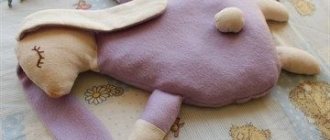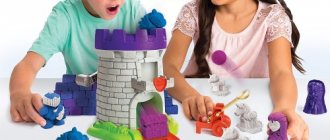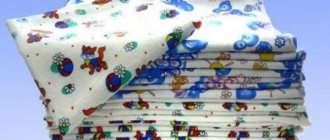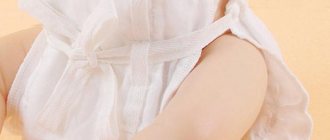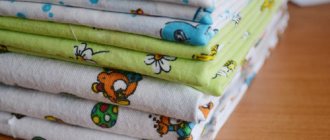What slings can you make yourself?
Any woman, even a novice needlewoman, can make a simple sling for carrying children at home. It won’t take much time to make, but you can save a decent amount of money.
Varieties:
- Scarf. This is a simple carrier in design, which is represented by a large piece of fabric. You can tie it in different ways.
- Model with rings. This is an ideal DIY sling for newborns from 0 to 6 months. When carrying older children, the load will fall on one shoulder, so it makes sense to choose a different model.
- Sling pocket. The model is very easy to use; it comes with a bag slung over the shoulders. The disadvantage of this option is that the harnesses are not adjustable.
This is a simple design that is easy to do yourself
For newborn children (up to six months), only two models can be used: a scarf and a version with rings.
On a note. When making a carrier for newborns, it is important to properly think through the design in order to fix the position of the child’s spine.
What is a sling scarf
This is a rectangular piece of fabric ranging from two and a half to seven meters in length. The width of different models varies from half a meter to a meter. The larger the sling size, the more variable the winding methods.
The advantage of a sling scarf over other models is its variability. The weight can be distributed evenly over two shoulders and the baby can be placed behind the back. Each woman chooses ways to tie a sling scarf that are suitable for her and her child.
There is only one drawback - the process of putting it on will initially take a lot of time. It will take time before the mother can wrap the sling scarf correctly.
What baby carriers can and cannot be made from
The most important thing when making a sling yourself is the choice of material. Important Requirements:
- strength;
- should not stretch much;
- natural composition.
Yellow nose in a child under one year old - causes of yellowing
To make a sling, you can buy a ready-made piece of fabric; sometimes it is more advisable to use materials and available tools at home:
- Sheet. It can only be used as a carrier during warm periods and at home. The material will not ensure the anatomically correct position of the child's spine.
- Stole. Used both at home and outdoors in the autumn-spring period.
- A cotton scarf measuring 150*100 cm. It could even be a diaper. In Africa, such carriers are called kanga.
On a note. You cannot use old things to make a sling, as the material loses its strength and elasticity over time. Such a carrier can become dangerous for the child.
You should not make your own baby sling from a knitted scarf. As a rule, they are narrow and easy to stretch.
You cannot take scarves of standard sizes (up to 100*100 cm). Woolen items are not suitable as they will be too scratchy. Silk items will not provide reliable support; the baby will slide in them.
How to choose and what are the differences?
The first and most important thing is to decide on the material. A linen sheet and a velvet curtain are not the best choice. It is too difficult to properly and comfortably wrap a child. To produce slings, they use knitwear and special scarf fabric, which is woven only for slings.
Knitted slings scarves
Knitted scarves are recommended for inexperienced mothers of newborn babies. This sling is easier to learn - it is first wrapped, and then the child is placed in it. The knitwear stretches, so there is virtually no additional pulling on the tails. Hence another plus - the ability to take the child out and put it in again without untying the scarf. This is convenient for mothers who actively drive cars and for clinics.
The main disadvantage of knitted scarves is their short lifespan. Quite quickly the child becomes heavy, the sling sags, and it becomes difficult and uncomfortable to carry the child. Therefore, knitwear usually becomes a temporary carrier until the child grows up to a backpack.
Knitted slings differ in the width of the fabric. It will be difficult to place an older child in a narrow sling. But, as we have already noted, knitted scarves are, in principle, not very comfortable for large children.
Domestic knitted slings-scarves are noticeably cheaper than imported ones. The quality is usually a little simpler - they are sewn from the knitwear that the manufacturer found on sale. Foreign manufacturers often participate in the production of fabric and its dyeing. For example, German knitted Manduka scarves are knitted from the finest cotton. And the MaM Eco knitted sling contains hemp, which makes it more load-bearing - it is easier to carry older children over 6-7 kg in it than in other knitted scarves.
Woven sling scarves
With woven scarves it's a little more complicated - there are too many options. To the delight of babywearing fans and to the horror of ordinary parents. The fabric - jacquard, double diagonal weaving, diamond weaving - has an important property. It stretches differently than regular fabric. Due to this, the child comfortably sags in the desired position, and the fabric does not stretch.
It is easier to place a child ergonomically in a woven sling, especially a small one. It is easier to carry already large, heavy children. There are more and more woven scarves every year, and this is where you can get confused.
Manufacturers of scarf slings usually differ in quality, colors (pattern) and the length of the bevels at the ends of the fabric. Foreign manufacturers can afford to weave slings from various materials - cotton, linen, bamboo, wool, silk and various combinations thereof. Domestic manufacturers, due to the price of threads of exotic compositions, are still developing mainly cotton slings-scarves. However, cotton scarves from some domestic manufacturers are not inferior to cotton scarves from foreign manufacturers, and their price is still lower.
Beginners should not immediately experiment with exotic options - due to the characteristics of the fabric, it will be more difficult to master the sling. It is better to choose something from the manufacturer’s basic collection. For newborns - softer and thinner, for older children - dense fabric, and something in between as a universal option.
Dimensions
Classic slings-scarves are available in several sizes to suit mothers and fathers of any figure. Manufacturers usually give recommendations on how to choose a sling of a convenient size.
| Sling scarf size | S (4.2 m) | M (4.6 m) | L (5.2 m) |
| Parent's clothing size | Up to 42 | Up to 48 | 50 or more |
The length of the sling-scarf indicated in the table with the appropriate size of clothing is enough to wrap the scarf in any of the ways with three layers of fabric on the back of the child (a cross with a turn inside, a cross with a turn outside and their variations on the back, on the hip, in the “ cradle") and tie a knot on the back (if the child is in front). In order to tie a knot under the child, you need to take a sling one size larger. For short wraps (simple cross, backpack), you can take a sling scarf one size smaller. It is worth remembering that windings that require less fabric are only suitable for older children, while longer windings make it easier to carry a child. Therefore, the most universal sizes of a scarf sling are 4.6 meters and 5.2 meters.
Quality
The quality of scarf slings usually corresponds to the price - cheap ones are really worse than expensive ones. This is because the sling is much more comfortable if it is made of special sling fabric.
Ulyana Romanovskaya, certified sling consultant at the Trageshule school, basic course. When reprinting, an active link is required.
Choosing material for a sling
What to do if your child doesn't sleep well at night
Before starting to make a sling at home, special attention is paid to the type and quality of the fabric. In order not to provoke the development of allergies in a child, choose its natural composition without the addition of synthetic threads:
- linen;
- cotton;
- wool.
When choosing fabric, they are guided by the season when they plan to carry the child in a sling:
- For summer time, buy chintz. The finished structure is reinforced with special frames. Without additional sealing, such things are used only for newborn babies with low birth weight.
- To make carriers that will be used during the off-season, purchase calico or denim.
- For winter, the carrier can be made of wool or a mixed material. The sling scarf can be made from thin fleece.
You can make a sling that is thinner for summer and thicker for winter.
To make slings, twill (a mixture of cotton and linen) and knitwear are purchased.
On a note! To prevent the product from shrinking, when using it, wash the piece of material before cutting and sewing.
DIY May-sling is ready!
It turned out to be double-sided - the second side is also quite nice.
You can add details to the sling such as a pocket on the back or sew additional support for the head from a piece of fabric to make it comfortable to carry a sleeping baby. This support is attached to the carrier with regular buttons and removed when it is not needed.
Elena Modenova spoke about how to sew a May-sling especially for the Active Mom website. Photo by the author
Rules for making a sling with rings
Apgar scale for newborns - scores at birth, table
To sew a sling with your own hands for a newborn, you will need a rectangular piece of fabric (200-240 cm long, 80 cm wide) and 2 metal rings. The pattern is a rectangle of the required size.
Model with sewing rings
A short master class on how to make a sling for a newborn baby with your own hands:
- The length of the flap for the product is selected depending on the height and physique of the parents. The larger the mother, the longer the piece of material should be.
- 3 edges are overcast.
- The rings are threaded through the material.
- The threaded rings are secured in a fabric loop. The free edge is sewn with 3 lines to the main fabric.
When using a model with rings, the entire load will fall on 1 shoulder of the mother
If you want to make the model more stylish, you can add folds to the shoulder.
Option with rings, but without sewing in
You can make a baby carrier without sewing. To do this, one end of the fabric is threaded through 2 rings at once. Measure approximately 40-45 cm of fabric and thread it into one of them. The short edge of the fabric is placed on the shoulder, and the long edge is wrapped around the body. Then, with this edge, first both rings are threaded, and then one of them.
Differences between a sling scarf and other carriers
The easiest way is to sew a sling scarf with your own hands for newborns. This is just a piece of fabric that needs to be correctly calculated in accordance with its dimensions. Other models need to be tried on.
Other benefits:
- the child can take different positions (sitting, lying down);
- allows you to tie in different ways (horizontally, vertically, sideways, behind);
- takes up little space in the bag, can be used as a regular stole;
- looks stylish and feminine with dresses, T-shirts or other clothes.
When choosing or making a sling scarf, it is important to choose the right length of the product.
The scarf can be tied so that the child is behind
Selection of materials and tools
To make a scarf carrier, you need to choose the right fabric. It should be a strong, dense material that does not stretch. To complete the product, you need to purchase a piece of material 5 m long and 70 cm wide.
On a note. To more accurately calculate the length of the fabric, you need to add 0 to the Russian size of the mother’s clothes on the right. Also take into account that after washing the fabric can shrink, so you can add 3-5%.
Sewing recommendations
The direct process of sewing a sling scarf is very simple:
- Decorate the ends of the fabric cut. They can be made straight, rounded or cut.
- Finish all edges to prevent them from fraying.
- If the sling is made of several parts, then all butt seams are made with double stitching.
After such simple measures, all that remains is to learn how to tie a sling correctly so that it guarantees the baby the correct position and securely fixes it.
How to sew a May-sling with your own hands: work order
We cut out all the parts we need from the fabric, not forgetting about seam allowances.
Back:
We cut off the corners at the top of both back parts like this:
The dimensions of the cut triangles are 7 cm on the sides, 10 cm on the base.
Top straps:
The photo shows one piece, but we cut out two.
Bottom strap:
We fold the waist strap in half along its entire length with the wrong side up and stitch it.
Turn it inside out.
The finished strap needs to be ironed.
We do the same with the top straps.
Now we insert the padding polyester into the upper straps.
This is not an easy task, but if you try, everything will work out. We insert the padding polyester so that one of its edges is flush with the upper end of the strap.
We sew the straps with padding polyester several times across in increments of 15-18 cm.
You can stitch the strap along the length of the padding polyester insert using some decorative stitch.
In my sling I combined both methods.
We process the raw edges of the straps, with the exception of those filled with padding polyester - they will disappear inside the back.
We fold the rectangular parts of the back with the right sides facing inward. We insert the upper straps between them so that they intersect in the center. Like this:
The ends of the straps should not coincide with the edge of the back parts; we pull them out a little further. This is necessary in order to then be able to properly fix the connection of the straps and the back of the sling.
We pin it all up with pins or baste it and stitch it on a machine. We sew from the middle of any of the sides, along the top and further, to the middle of the other side.
We take out the pins (if you pinned the sling), turn it inside out and iron it, carefully going around the places with padding polyester.
We insert the waist strap down, fold the edges of the product under it and sweep it away.
We sew the May-sling around the entire perimeter.
For strength I used double stitches.
At the bottom, at a distance of approximately 7-8 cm from the edge of the product, we lay a stitch across it - we need it to fix the upper edge of the waist strap.
Now we reinforce the attachment points of the upper straps with additional stitching.
You can stitch the joints with a triangle, a square, a square with a cross inside - choose to your taste.
Why sew a sling yourself?
Since children need constant tactile contact with their mother, they recommend carrying the newborn in your arms. Using a sling, you can combine communication with your child and doing some things, for example, shopping or an evening walk.
While in the sling, the baby not only has contact with the mother’s body, he is given a light massage, his spine takes the most comfortable position, and the mother does not feel the same discomfort as from being carried in her arms. In a sling, the baby will not miss feeding, as he will be close to the breast.
The cost of the finished product is relatively high; making it yourself allows you to save money. It is also much easier to choose the desired color than to find such a finished product. Scarf slings look very stylish and feminine, and can later be used as stoles.
Safety precautions
If this is your first time trying to carry your baby in a sling, be sure to place him in the sling over a soft surface. When wearing, support your body with your hands until you feel confident.
If the child is wearing a scarf in the “column” position, the cloth should not fall below the shoulder blades. Otherwise, the baby may simply fall out of the sling.
Never lean forward while carrying a baby in a scarf. You may hurt your back or fall. Sit down only with a straight back and legs wide apart.
Do not press the baby's chin tightly to the chest; it will be difficult for him to breathe and asphyxia may occur.
Use your hands to protect your baby's head when walking past corners, in narrow doorways or in cluttered rooms.
When walking in a sling scarf, choose only comfortable shoes with flat soles; it is better to avoid laces and complicated fasteners, so you can easily put on and take off your shoes if necessary.
In a car, a sling cannot replace a car seat. Use a special bassinet for babies.
In public transport, make sure that the baby is visible from under the sling: others may accidentally injure him with an awkward movement. It is not advisable to ride while standing; your position is unstable and the newborn's head may twitch during sudden braking.
Newborn babies should not be carried in a sling facing away from you. Even if you think that this way the child will be able to view the world around him or have seen this method of wearing from other parents, give it up at least until the moment when the back is so strong that the baby can sit independently. This method of wearing is unphysiological and puts a strong load on the lower back, while the body bends outward, which is fraught with injury.
Choose the method of tying the sling that is convenient for you, and you will be surprised how much more convenient it will be to do household chores and walk with your little miracle. When tied correctly, all types of slings secure a position that is beneficial for the baby’s back and legs. A pose with widely spread “frog” legs is recommended by pediatricians for hip dysplasia. The physiological position in the sling and the warmth of the mother's body will help to cope with the most common problem of infants - colic. Maintaining close contact with your baby is very important for any mother, and a sling will help your baby constantly feel his mother’s care!
How to use a homemade sling
After making a carrier with your own hands, it is important to use it correctly.
Carriers with rings are worn as follows:
- Throw it over the shoulder so that the rings are below its level.
- The free edge is passed into both rings, then into one for fixation.
- The edges of the canvas are pulled apart to make a cradle, and the child is placed there.
Before putting your child in a scarf, you need to practice tying and securing the product.
Modern slings for carrying children are not only comfortable, but also stylish devices. Mothers do not need to pull strollers, while the child remains nearby. In order not to spend a lot of money on purchasing a sling, you can do it yourself, even without knowing how to sew.


